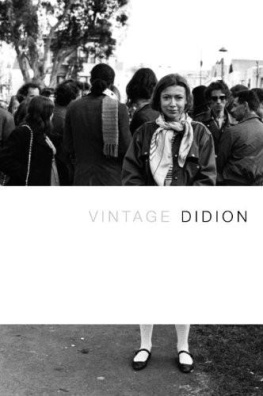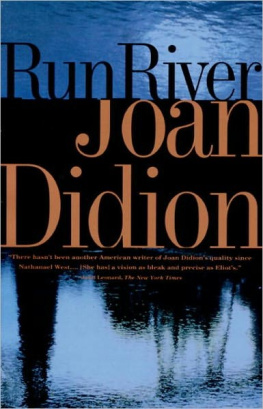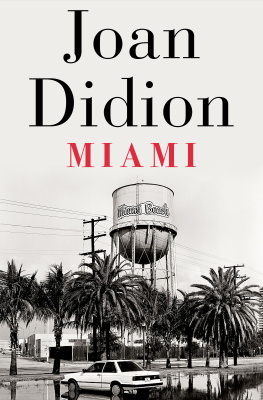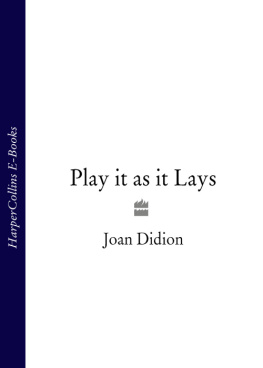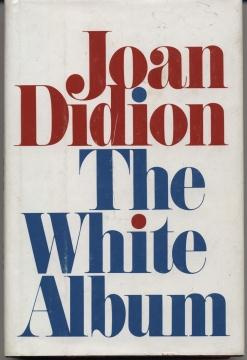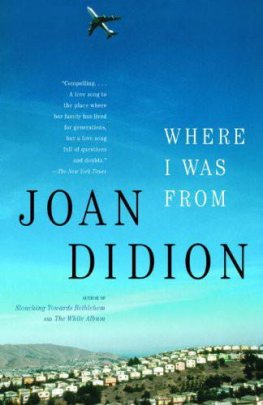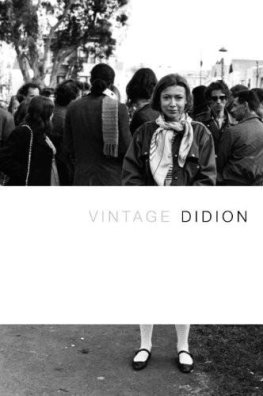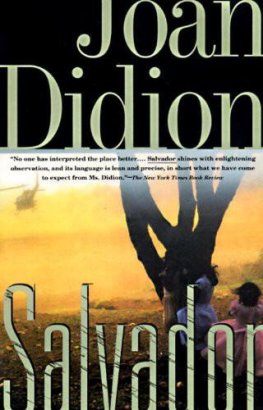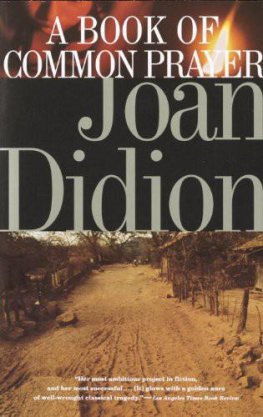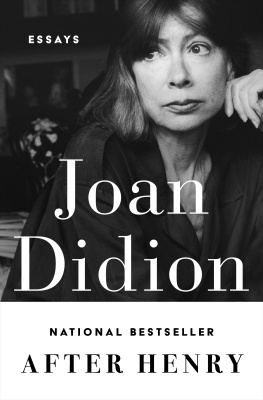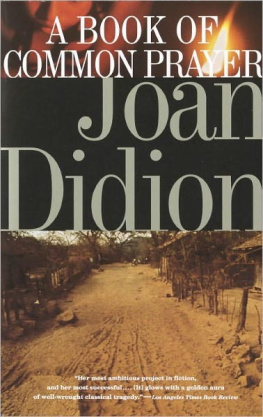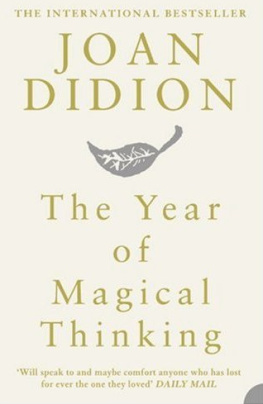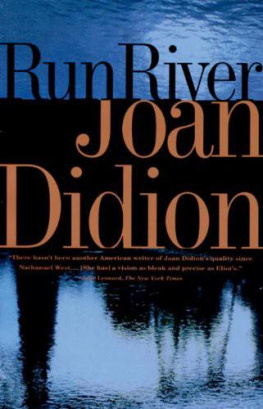Joan Didion VINTAGE DIDION Joan Didion was born in Sacramento on December 5, 1934. She graduated from the University of California, Berkeley, in 1956 and began working for Vogue . For many years her essays and reporting appeared in The Saturday Evening Post, Esquire , and New West . In 1963 Didion made her fictional debut with Run River , a novel about a hop growers wife in the Sacramento Valley. Over the course of her career, Didion has published four other novels. Her second work of fiction, Play It As It Lays (1970), follows a young woman through Hollywood and Las Vegas in the late 1960s, while A Book of Common Prayer (1977) intertwines the stories of two American women in a fictional Central American country. In 1984 she completed Democracy , a darkly comic novel set in Hawaii and Southeast Asia at the end of the Vietnam War. Her most recent work of fiction, The Last Thing He Wanted (1996), traces a thrilling narrative of discovery and conspiracy. Didions first volume of nonfiction, Slouching Towards Bethlehem , was published in 1968 to overwhelming critical acclaim. This collection of essays captures the spirit of America in the 1960s, focusing on the counterculture of California. In 1979 Didion published her second collection, The White Album , which included reflections on the Manson murders, the Black Panthers, and Georgia OKeeffe. In the 1980s Didion wrote two studies on United States foreign policy in Central America. These pieces were published together in 1983 as Salvador , which is still regarded as one of the most important works of American political reporting. Miami (1987) makes the connection between the Cuban exile community and Washington, while both After Henry (1992) and Political Fictions (2001) deconstruct American culture and the political process. Her most recent book, Where I Was From , is about California, about America, about her history and ours and about the contradictions in the stories we tell ourselves about our past and our present. With her husband, John Gregory Dunne, Didion has cowritten screenplays for several movies including The Panic in Needle Park, Play It As It Lays, A Star Is Born, True Confessions, Broken Trust , and Up Close and Personal . A contributor to The New York Review of Books and The New Yorker , she lives in New York City. BOOKS BY JOAN DIDION Run River Slouching Towards Bethlehem Play It As It Lays A Book of Common Prayer The White Album Salvador Democracy Miami After Henry The Last Thing He Wanted Political Fictions Where I Was From

CONTENTS
GIRL OF THE GOLDEN WEST
T he domestic details spring to memory. Early on the evening of February 4, 1974, in her duplex apartment at 2603 Benvenue in Berkeley, Patricia Campbell Hearst, age nineteen, a student of art history at the University of California at Berkeley and a granddaughter of the late William Randolph Hearst, put on a blue terry-cloth bathrobe, heated a can of chicken-noodle soup and made tuna fish sandwiches for herself and her fianc, Steven Weed; watched Mission Impossible and The Magician on television; cleaned up the dishes; sat down to study just as the doorbell rang; was abducted at gunpoint and held blindfolded, by three men and five women who called themselves the Symbionese Liberation Army, for the next fifty-seven days.
From the fifty-eighth day, on which she agreed to join her captors and was photographed in front of the SLAs cobra flag carrying a sawed-off M-1 carbine, until September 18, 1975, when she was arrested in San Francisco, Patricia Campbell Hearst participated actively in the robberies of the Hibernia Bank in San Francisco and the Crocker National Bank outside Sacramento; sprayed Crenshaw Boulevard in Los Angeles with a submachine gun to cover a comrade apprehended for shoplifting; and was party or witness to a number of less publicized thefts and several bombings, to which she would later refer as actions, or operations.
On trial in San Francisco for the Hibernia Bank operation she appeared in court wearing frosted-white nail polish, and demonstrated for the jury the bolt action necessary to chamber an M-1. On a psychiatric test administered while she was in custody she completed the sentence Most men with the words are assholes. Seven years later she was living with the bodyguard she had married, their infant daughter, and two German shepherds behind locked doors in a Spanish-style house equipped with the best electronic security system available, describing herself as older and wiser, and dedicating her account of these events, Every Secret Thing , to Mom and Dad.
It was a special kind of sentimental education, a public coming-of-age with an insistently literary cast to it, and it seemed at the time to offer a parable for the period. Certain of its images entered the national memory. We had Patricia Campbell Hearst in her first-communion dress, smiling, and we had Patricia Campbell Hearst in the Hibernia Bank surveillance stills, not smiling. We again had her smiling in the engagement picture, an unremarkably pretty girl in a simple dress on a sunny lawn, and we again had her not smiling in the Tania snapshot, the famous Polaroid with the M-1. We had her with her father and her sister Anne in a photograph taken at the Burlingame Country Club some months before the kidnapping: all three Hearsts smiling there, not only smiling but wearing leis, the father in maile and orchid leis, the daughters in pikake, that rarest and most expensive kind of lei, strand after strand of tiny Arabian jasmine buds strung like ivory beads.
We had the bank of microphones in front of the Hillsborough house whenever Randolph and Catherine Hearst (Dad and Mom in the first spectral messages from the absent daughter, pig Hearsts as the spring progressed) met the press, the potted flowers on the steps changing with the seasons, domestic upkeep intact in the face of crisis: azaleas, fuchsias, then cymbidium orchids massed for Easter. We had, early on, the ugly images of looting and smashed cameras and frozen turkey legs hurled through windows in West Oakland, the violent result of the Hearsts first attempt to meet the SLA ransom demand, and we had, on television the same night, the news that William Knowland, the former United States senator from California and the most prominent member of the family that had run Oakland for half a century, had taken the pistol he was said to carry as protection against terrorists, positioned himself on a bank of the Russian River, and blown off the top of his head.
All of these pictures told a story, taught a dramatic lesson, carrying as they did the frisson of one another, the invitation to compare and contrast. The image of Patricia Campbell Hearst on the FBI wanted fliers was for example cropped from the image of the unremarkably pretty girl in the simple dress on the sunny lawn, schematic evidence that even a golden girl could be pinned in the beam of history. There was no actual connection between turkey legs thrown through windows in West Oakland and William Knowland lying facedown in the Russian River, but the paradigm was manifest, one California busy being born and another busy dying. Those cymbidiums on the Hearsts doorstep in Hillsborough dissolved before our eyes into the image of a flaming palm tree in south-central Los Angeles (the model again was two Californias), the palm tree above the stucco bungalow in which Patricia Campbell Hearst was believed for a time to be burning to death on live television. (Actually, Patricia Campbell Hearst was in yet a third California, a motel room at Disneyland, watching the palm tree burn as we all were, on television, and it was Donald DeFreeze, Nancy Ling Perry, Angela Atwood, Patricia Soltysik, Camilla Hall, and William Wolfe, one black escaped convict and five children of the white middle class, who were dying in the stucco bungalow.)
Next page
